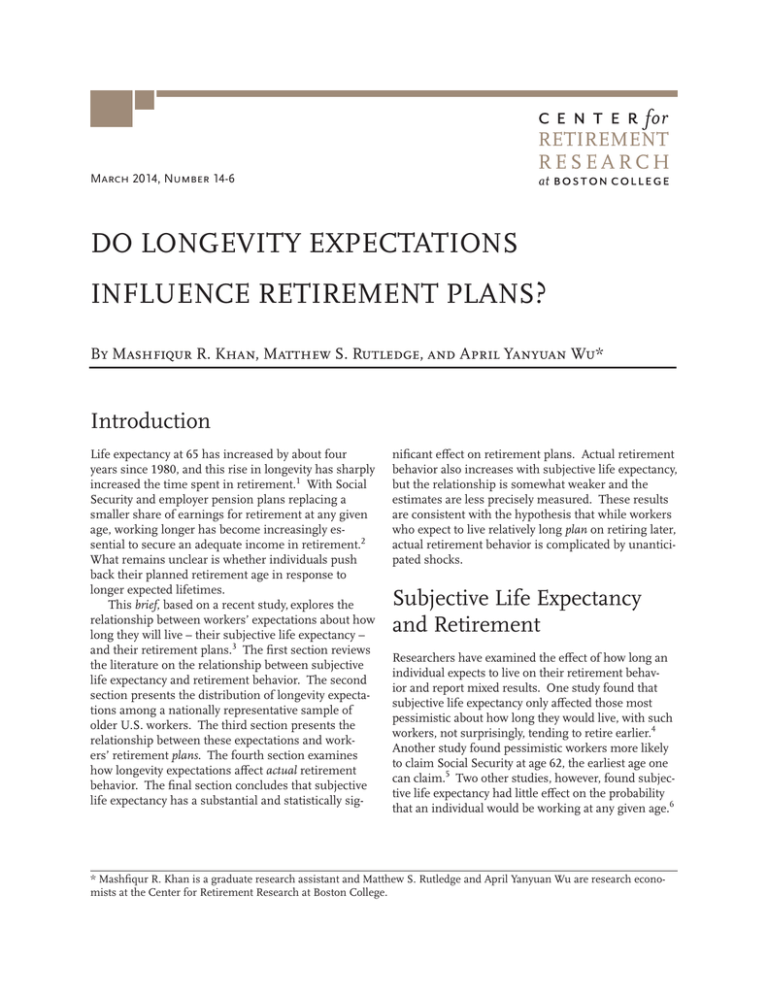
RETIREMENT
RESEARCH
March 2014, Number 14-6
DO LONGEVITY EXPECTATIONS
INFLUENCE RETIREMENT PLANS?
By Mashfiqur R. Khan, Matthew S. Rutledge, and April Yanyuan Wu*
Introduction
Life expectancy at 65 has increased by about four
years since 1980, and this rise in longevity has sharply
increased the time spent in retirement.1 With Social
Security and employer pension plans replacing a
smaller share of earnings for retirement at any given
age, working longer has become increasingly essential to secure an adequate income in retirement.2
What remains unclear is whether individuals push
back their planned retirement age in response to
longer expected lifetimes.
This brief, based on a recent study, explores the
relationship between workers’ expectations about how
long they will live – their subjective life expectancy –
and their retirement plans.3 The first section reviews
the literature on the relationship between subjective
life expectancy and retirement behavior. The second
section presents the distribution of longevity expectations among a nationally representative sample of
older U.S. workers. The third section presents the
relationship between these expectations and workers’ retirement plans. The fourth section examines
how longevity expectations affect actual retirement
behavior. The final section concludes that subjective
life expectancy has a substantial and statistically sig-
nificant effect on retirement plans. Actual retirement
behavior also increases with subjective life expectancy,
but the relationship is somewhat weaker and the
estimates are less precisely measured. These results
are consistent with the hypothesis that while workers
who expect to live relatively long plan on retiring later,
actual retirement behavior is complicated by unanticipated shocks.
Subjective Life Expectancy
and Retirement
Researchers have examined the effect of how long an
individual expects to live on their retirement behavior and report mixed results. One study found that
subjective life expectancy only affected those most
pessimistic about how long they would live, with such
workers, not surprisingly, tending to retire earlier.4
Another study found pessimistic workers more likely
to claim Social Security at age 62, the earliest age one
can claim.5 Two other studies, however, found subjective life expectancy had little effect on the probability
that an individual would be working at any given age.6
* Mashfiqur R. Khan is a graduate research assistant and Matthew S. Rutledge and April Yanyuan Wu are research economists at the Center for Retirement Research at Boston College.
2
Center for Retirement Research
This study builds on the literature by examining the effect of subjective life expectancy on both
planned and actual retirement behavior. Since actual
retirement behavior is affected by shocks – health
problems, layoffs, the need to care for a loved one, or
financial gains or losses – the effect of subjective life
expectancy should be better reflected in a worker’s
retirement plans, not in how circumstances play out.
Accuracy and Variance in
Subjective Life Expectancy
The data source for the analysis is the Health and
Retirement Study (HRS), a survey administered to a
panel of older workers and retirees every two years.
The HRS asks respondents to estimate their probability of living to ages 75 and 85. The analysis used the
responses to these questions for workers age 50 to 61
as indicators of their subjective life expectancy (SLE).7
Workers in the sample, on average, estimated that
they had a 68-percent chance of living to age 75 and a
47-percent chance of living to age 85. These average
estimates are quite similar to “objective” life expectancy (OLE) estimates derived from actuarial life tables:
based on their age, sex, and birth year, 70 percent of
the workers in the sample are expected to live to age
75 and 42 percent to age 85. Thus, the average SLE
estimate was just 2 percentage points below the age75 OLE estimate and 5 percentage points above the
age-85 OLE estimate.
Figure 1. Worker Estimates of Their Likelihood
of Living to Ages 75 and 85, by SLE Tercile
100%
80%
Est. likelihood of living to age 75
75
Est. likelihood of living to age 85
85
72%
60%
40%
20%
94%
70%
51%
37%
21%
0%
Lowest third
Middle third
Source: Khan, Rutledge, and Wu (2014).
Highest third
Workers’ estimates of their chances of living to
the target ages varied widely. Perhaps due to health
concerns or family history, the third of respondents
with the lowest SLE estimates thought they had only
a 37-percent chance, on average, of living to age 75
and only a 21-percent chance of living to age 85. The
third of respondents with the highest SLE estimates,
by contrast, thought they had a 94-percent chance of
living to age 75 and a 70-percent chance of reaching
age 85 (see Figure 1).
SLE and Retirement Plans
The first part of the analysis examines the effect of
a worker’s longevity expectations on his retirement
plans. Retirement plans were measured using three
HRS questions. The first question is when the respondent plans to retire. The most frequent responses are ages 62 and 65, though other ages are also common.8 The other two questions are the respondent’s
estimate of his probability of working full-time at ages
62 and 65. On average, 48 percent expect to work fulltime at age 62 and 28 percent at age 65.9
The task is to use a regression equation to estimate the relationship between a worker’s retirement
plans and his longevity expectations, controlling for
a large set of factors that previous studies have found
affected these plans. These control variables include
personal, family, and employment characteristics,
pension and health insurance coverage, and health
status. So, the basic equation is:
Retirement plans = f(SLE, control variables)
But certain adjustments are needed to refine this
approach. The first issue is that differences in workers’ SLEs may be due to differences in longevity based
on the age at which they are interviewed, their gender,
and the ongoing rise in life expectancy. For instance,
a 62-year-old is likely to have a more accurate view of
his probability of reaching age 75 than a 51-year-old;
women live longer than men; and younger cohorts
generally live longer than older cohorts. To address
these concerns, each worker’s SLE is standardized
by focusing on the difference between the worker’s
estimate of his chances of living to age 75 (or 85) and
the actuarial objective life expectancy estimate for all
individuals with the same age, sex, and birth year.10
With this adjustment, the equation becomes:
Retirement plans = f((SLE-OLE), control variables)
3
Issue in Brief
(SLE-OLE) = f(parents alive, parents’ current ages,
parents’ ages at death, control variables)
In the second stage, the predicted value of workers’
standardized life expectancy from the first stage is
entered into the equation that relates retirement plans
to life expectancy, as follows:
∟
Even with the standardized measure, though, a
concern is that the correlation between life expectancy
and retirement plans may be driven by an unobserved third factor, such as optimism about life in
general, not just optimism about longevity. Moreover,
other researchers have found that SLE responses are
bunched at focal points, with many respondents estimating their chances of living to a particular age as
0, 50, or 100 percent, rather than points in between.
Some respondents also report a higher probability of
living to 85 than 75.11
Addressing these issues requires identifying an
instrumental variable and then adopting a two-stateleast-squares process. Introducing an instrumental
variable, which is correlated with the independent
variable of interest but otherwise unrelated to the
dependent variable, offers a way to test whether the
relationship between the independent and dependent
variables is causal rather than merely a correlation.
The first stage involves regressing workers’ standardized life expectancy on all of the control variables in
the model and the instrumental variables. The set of
instrumental variables used in the first stage is based
on the experience of the respondent’s parents: an
indicator for whether each parent is alive, the parents’
current ages if still living and their age at death if not.
The behavioral economics literature suggests that a
worker may use his parents’ mortality experience as
a guide in estimating his own mortality. So parents’
mortality should be correlated with SLE, but should
be unrelated to retirement outcomes except through
SLE.12 The equation for the first stage is:
Retirement plans = f((SLE-OLE), control variables)
The resulting analysis found a statistically significant relationship between how long workers expect to
live and when they expect to retire and how long they
expect to work full-time. Figure 2 shows the effect of
a swing from the median worker longevity expectations to the average of the highest third. Such an
increase in SLE raises a worker’s expected retirement
age by 4 months; it increases expectations of working full-time at age 62 and age 65 by 4-5 percentage
points. These effects are substantial, and all results
are statistically significant.
SLE and Actual Retirement
Behavior
The next step (which also relies on the instrumental
variable approach) is to examine the relationship
between worker expectations about how long they will
live and their actual retirement behavior, using data
from HRS respondents with an observable retirement
date or observable work status at ages 62 and 65.13
Figure 2. Estimated Effect of Swing From Median to Highest Tercile of Longevity Expectations on
Work and Retirement Expectations
4.2
Expected retirement age (months)
3.6
Expectation of living to age 75
Expectation of living to age 85
4.2
4.2
Likelihood of working full-time
at age 62 (percentage points)
5.2
5.1
Likelihood of working full-time
at age 65 (percentage points)
0
Source: Khan, Rutledge, and Wu (2014).
2
4
6
4
Center for Retirement Research
Figure 3. Estimated Effect of Swing From Median to Highest Tercile of Longevity Expectations on
Actual Retirement Behavior
1.5
Retirement age (months)
0.6
Striped – not statistically significant
Solid – statistically significant
Expectation of living to age 75
Expectation of living to age 85
1.7
Work full-time at age 62
(percentage points)
3.0
6.2
Work full-time at age 65
(percentage points)
5.5
0
1
2
3
4
5
6
7
Source: Khan, Rutledge, and Wu (2014).
The results show the relationship between a worker’s standardized SLE and his actual retirement age
and actually working full-time at 62 to be positive, but
smaller in magnitude than the estimates for expected
retirement behavior and not statistically significant
(Figure 3).14 Expectations about living to age 75 and
85, however, had a strong positive and statistically significant effect on the probability of working full-time
at age 65.
Conclusion
Workers who think they have excellent chances of
living to ages 75 and 85 expect to work longer and
retire later than workers who think their chances are
poor. Subjective life expectancy also affects actual
retirement behavior, though to a lesser degree than
retirement expectations. These results are consistent
with the notion that while workers who expect to live
longer plan to retire later, actual retirement plans are
influenced by unexpected shocks.
Issue in Brief
5
Endnotes
1 U.S. Social Security Administration (2012); and authors’ calculations from U.S. Census Bureau, Current
Population Survey, 1980 and 2013.
13 The expected retirement results using just this
selected sample are consistent with the results shown
in Figure 2.
2 Munnell and Sass (2008).
14 Although the coefficients for actual retirement
behavior are not statistically significantly different
from zero, we cannot reject the null hypothesis that
the estimates in the actual retirement regressions are
statistically significantly different from those from the
expected retirement regressions. The failure to reject
the null of equivalence between the expected and
actual estimates means that our finding is consistent
with Benitez-Silva and Dwyer (2005), which finds that
retirement expectations and actual retirement behavior are closely linked.
3 Khan, Rutledge, and Wu (2014).
4 Hurd, Smith, and Zissimopoulos (2004).
5 Delavande, Perry, and Willis (2006).
6 Hamermesh (1984) and Bloom et al. (2006).
7 For details about the sample, see Khan, Rutledge,
and Wu (2014).
8 The study excluded the 4.5 percent of respondents
who refused to answer or did not have a plan and the
6.8 percent who reported that they will never retire.
9 The average expected retirement age is 63, but only
48 percent expect to work full-time at age 62; this
finding indicates that a portion of those not expecting
to work full-time at age 62 expect to work part-time
and, thus, do not consider themselves retired.
10 A value greater than zero indicates that the individual thinks that he has a higher probability of living
to the given age than the actuarial estimate for his
peer group. We also estimate results that use the SLE
by itself, and the results are very consistent.
11 Hurd and McGarry (1995); Hurd, McFadden,
and Gan (1998); Bassett and Lumsdaine (2001); and
Bloom et al. (2006).
12 Hurd and McGarry (1995) document that parents’
mortality and SLE are positively correlated. This
instrument is also used by Bloom et al. (2006). The
first-stage regression indicates that these instruments
are appropriately used, but the reduced-form results
are qualitatively similar. The analysis also controlled
for whether respondents take care of their parents,
and the results are largely unaffected.
6
Center for Retirement Research
References
Bassett, William F. and Robin L. Lumsdaine. 2001.
“Probability Limits: Are Subjective Assessments
Adequately Accurate?” Journal of Human Resources
36(2): 327-63.
Munnell, Alicia H. and Steven A. Sass. 2008. Working Longer: The Solution to the Retirement Income
Challenge. Washington, DC: Brookings Institution
Press.
Benitez-Silva, Hugo and Debra S. Dwyer. 2005. “The
Rationality of Retirement Expectations and the
Role of New Information.” Review of Economics
and Statistics 87(3): 587-592.
U.S. Social Security Administration. 2012. The 2012
Annual Report of the Board of Trustees of the Federal
Old-Age and Survivors Insurance and Federal Disability Insurance Trust Funds. Washington, DC:
Government Printing Office.
Bloom, David E., David Canning, Michael Moore, and
Younghwan Song. 2006. “The Effect of Subjective
Survival Probabilities on Retirement and Wealth
in the United States.” Working Paper 12688.
Cambridge, MA: National Bureau of Economic
Research.
Delavande, Adeline, Michael Perry, and Robert Willis.
2006. “Probabilistic Thinking and Early Social Security Claiming.” Working Paper 129. Ann Arbor,
MI: University of Michigan Retirement Research
Center.
Hamermesh, Daniel S. 1984. “Life-Cycle Effects on
Consumption and Retirement.” Journal of Labor
Economics 2(3): 353-370.
Hurd, Michael D., James P. Smith, and Julie M. Zissimopoulos. 2004. “The Effects of Subjective Survival on Retirement and Social Security Claiming.”
Journal of Applied Econometrics 19(6): 761-775.
Hurd, Michael D., Daniel McFadden, and Li Gan.
1998. “Subjective Survival Curves and Life Cycle
Behavior.” In David Wise (ed.), Inquiries in the
Economics of Aging. Chicago: University of Chicago
Press.
Hurd, Michael D. and Kathleen McGarry. 1995. “Evaluation of the Subjective Probabilities of Survival.”
Journal of Human Resources 30: S268-92.
Khan, Mashfiqur R., Matthew S. Rutledge, and April
Yanyuan Wu. 2014. “How Do Subjective Longevity
Expectations Influence Retirement Plans?” Working Paper 2014-1. Chestnut Hill, MA: Center for
Retirement Research at Boston College.
U.S. Census Bureau. Current Population Survey, 1980
and 2013. Washington, DC.
RETIREMENT
RESEARCH
About the Center
The mission of the Center for Retirement Research
at Boston College is to produce first-class research
and educational tools and forge a strong link between
the academic community and decision-makers in the
public and private sectors around an issue of critical importance to the nation’s future. To achieve
this mission, the Center sponsors a wide variety of
research projects, transmits new findings to a broad
audience, trains new scholars, and broadens access to
valuable data sources. Since its inception in 1998, the
Center has established a reputation as an authoritative source of information on all major aspects of the
retirement income debate.
© 2014, by Trustees of Boston College, Center for Retirement Research. All rights reserved. Short sections of text,
not to exceed two paragraphs, may be quoted without explicit permission provided that the authors are identified and
full credit, including copyright notice, is given to Trustees of
Boston College, Center for Retirement Research.
Affiliated Institutions
The Brookings Institution
Massachusetts Institute of Technology
Syracuse University
Urban Institute
Contact Information
Center for Retirement Research
Boston College
Hovey House
140 Commonwealth Avenue
Chestnut Hill, MA 02467-3808
Phone: (617) 552-1762
Fax: (617) 552-0191
E-mail: crr@bc.edu
Website: http://crr.bc.edu
The research reported herein was performed pursuant to
a grant from the U.S. Social Security Administration (SSA)
funded as part of the Retirement Research Consortium. The
opinions and conclusions expressed are solely those of the
authors and do not represent the opinions or policy of SSA,
any agency of the federal government, or the Center for
Retirement Research at Boston College.




